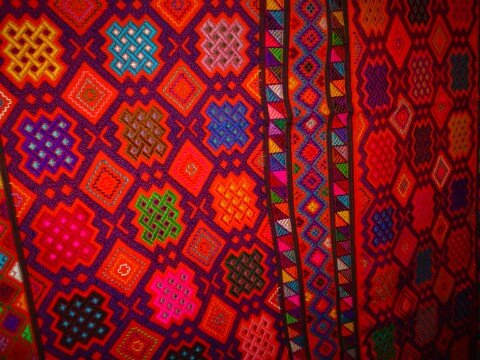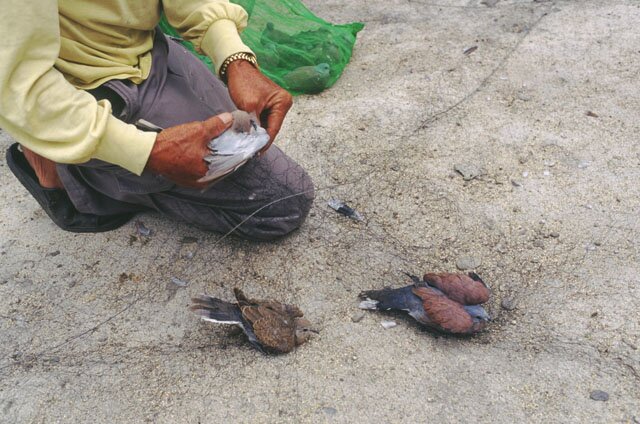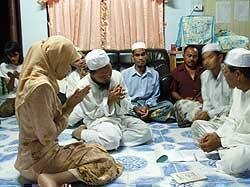BROWSE COUNTRIES/ TERRITORIES
There was an old woman who lived in a tent

In East Jerusalem, Jewish settlers have kicked an old Arab woman out of her home. She could soon be joined by members of 27 other Arab families being evicted to make way for other settler homes.
These are the kind of settlements that will test the Obama administration's sway over the Israeli government.
Mrs al-Kurds is 64. She once had a house in the Sheikh Jarrah neighbourhood of East Jerusalem. One day, Jewish settlers moved into one half of her home, and she went to court to try to evict them. The order was given, but the Housing Committee refused to evict the settlers. Instead last November, the Israeli Army arrived in the early hours of the morning and forcibly removed Mrs al-Kurds and her husband from their home.
Mr al-Kurds died two weeks later from a heart attack and Mrs al-Kurds moved into a tent built on land near her home which belonged to a friend of the family. The tent was demolished six times by the Israeli police, and rebuilt six times. It now stands with permission from the Israeli authorities.
The tent has become more of a protest against the Israeli-Arabs living in this neighbourhood. Mrs al-Kurds does not sleep in the tent anymore. She spends the night instead with a family, but during the day she is there at the tent. She has become famous among those who have heard the story of Um Kamel, the name she is better known by in the community, but Mrs al-Kurds' story is just one of the many in this enclave of Israeli-Arab homes of Sheikh Jarrar.

Mrs al-Kurd's protest tent. Her house was among the houses in the background now lived in by Jewish settlers.
51-year old Maher Hannoun lives in a house across from the Um Kamel tent. The simple one-storey house has a fence around it, from behind which he sat and told me his story, just one of 27 other similar ones.
The family's house had been built by the Jordanian government back in the 1950s, when it still controlled East Jerusalem, to house Palestinian refugees displaced by the creation of the State of Israel in 1948. The families would pay a token sum of rent, and after three years, ownership was to be transferred to them.
In 1967, East Jerusalem came under Israeli control. The Sephardic Community Committee and the Ashkenazi Community Committee claimed the area which is believed to hold the tomb of an ancient Jewish priest Shimon Hatzaddik. They asked the Israeli-Arab home owners to pay them rent, which the homes refused. The rent money, according to Hannoun, was collected and is being held by the court.
In 1972, the two committees transferred ownership to a settler organisation called Nahalat Shimon. The organisation tried to pay the Arab home owners to leave the area, but they refused.
“I was born here, this is my family home,” explained Hannoun.

The entrance to the Arab neighbourhood of Sheikh Jarra in disputed East Jerusalem.
According to Salah Abu Hussein, the lawyer representing the Arab families, the land belongs to Hijaze, a Palestinian from Jerusalem. Nahalat Shimon then produced a set of documents from the Ottoman-era to back the Jewish claim of ownership.
Earlier this year, with the war in Gaza, a worsening of relations between Israel and Turkey, a close traditional political and military ally, turned the tide in favour of the Arab families.
According to an interview with The National,
“We have noticed a dramatic change in the atmosphere now when we approach Turkish officials,” said Hatem Abu Ahmad, one of Mrs al-Kurd's lawyers. “Before they did not dare upset Israel and put us off with excuses about why they could not help.”
He said the families’ lawyers were finally invited to the archives in Ankara in January, after they submitted requests over several months to the Turkish consulate in Jerusalem and the Turkish Embassy in Tel Aviv.
Officials in Turkey traced the documents the lawyers requested and provided affidavits that the settlers’ land claims were forged. The search of the Ottoman archives, Mr Abu Ahmad said, had failed to locate any title deeds belonging to a Jewish group for the land in Sheikh Jarrah.
Unfortunately the Turkish change of heart came too late and the new evidence was rejected by the Israeli Supreme Court. Hannoun now faces a deadline of July 19 to evacuate from his family home. In May, the Israeli court ruled that if he did not, he would have to pay 50,000 shekels (almost US$12,000 ), another 5,000 shekels for court expenses and a backdated fine of 500 shekels a day for not evacuating, that would amount to another 150,000 shekels.

A map stuck on the Hannoun home shows the layout of the community of Sheikh Jarra. His is the house outlined in bold at the bottom tip.
Hannoun is resolute in not moving from his home. He has international activists staying with him to provide support and solidarity, and Hannoun has been tirelessly talking to visitors and media who will hear his case. Having lost in the legal system for his right to remain, he is hoping media pressure will prevent the Israeli authorities from evicting out of his home.
In most other countries, eviction of residents arising from government takeover of property might be seen as a tool of urban development and would not have raised a ruckus. The evicted would be compensated. In this case, the Nahalat Shimon have offered the Arab houseowners almost a blank cheque for compensation, but the situation is a lot more complicated.
As Hannoun put it, “They don't understand the connect between us and this land. They thought that with money, they can buy our memories or identities.”
At the crux of all this is the issue of what constitutes Israeli territory in Jerusalem. The Jewish takeover of Sheikh Jarra and subsequent building of settler homes on demolished Arab homes means that the northern Arab neighbourhoods will be cut off from the Old City of Jerusalem. What this will impact then is the territories that may be negotiated as Palestinian and Israeli territory in any peace talks regarding the disputed city, which both sides are claiming as capital for their respective states.
“We feel sad because we know that after we leave, they will move in the settlers,” said Hannoun. “If I do it (take the compensation), I will never respect myself and my sons will never respect me.”
A similar situation is taking place in Silwan, another Arab neighbourhood just outside the eastern walls of the Old City. Speaking specifically about it, US Secretary of State Hillary Clinton had called situations like these demolition of the Silwan houses for an archaeological park “unhelpful”. Earlier this month, President Barack Obama also called for a freeze on settlements and renewed that call in his much-anticipated speech in Cairo yesterday.
The al-Kurds' eviction from their homes last November took place before the election of Obama, despite pressure from the US. Now that he is in the Oval Office, many will be watching it to see how much influence, the new American president has over the Israeli government with his tough rhetoric.
This is the last in a series of three stories looks at the issue of land in the Israeli-Palestinian conflict, with a special focus on the city of Jerusalem. Next, we visit the city of Hebron, where Israelis and Palestinians are living in an area too close for comfort.
< BACK to previous post THE ISRAELI-PALESTINIAN NUMBERS GAME
< BACK to other stories in FROM JERUSALEM TO THE WEST BANK
Login or Register
 Dan-Chyi Chua began her writing career with Channel News Asia, a regional cable network, before forsaking broadcast journalism to hit the road for a three-year sabbatical through the Middle East, China, Central America and Cuba. She has now grounded herself as a writer for asia! Magazine.
Dan-Chyi Chua began her writing career with Channel News Asia, a regional cable network, before forsaking broadcast journalism to hit the road for a three-year sabbatical through the Middle East, China, Central America and Cuba. She has now grounded herself as a writer for asia! Magazine.
- Asian Dynasties and History
- Conservation of the Environment
- Definition: Culture
- Economy and Economics
- Food and Recipe
- Geopolitics and Strategic Relations
- Health and Body
- Of Government and Politics
- Religion and Practices
- Social Injustices and Poverty Report
- Society, Class and Division
- Unrest, Conflicts and Wars































 Another Point
Another Point From Jerusalem to the West Bank
From Jerusalem to the West Bank
Comments
Post new comment